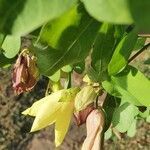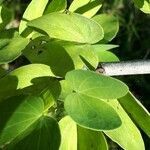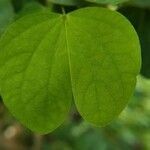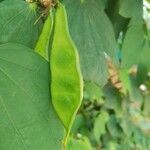Shrub or tree up to 8 m high; young branchlets glabrous, puberulous or ± pubescent. Leaves: petiole 0.6-2 cm long; blade very variable in size, 1-7 cm long, 1-6.5 cm wide (in our area), mostly bilobed apically to about one-third of the way down, rarely to half way or more, lower surface glabrous, appressed-puberulous or ± pubescent. Stipules 3-5 mm long, ±1 mm wide. Inflorescence 1-2(7)-flowered, terminal or lateral; bracteoles small and inconspicuous. Flower-buds: upper part (i.e. sepals) ovate in outline, 1-2 cm long before anthesis, glabrous or pubescent outside; hypanthium 2-8 mm long, smooth or finely longitudinally sulcate; pedicels 0.7-2.5 cm long. Petals sulphur-yellow, 1-3 of them often (not always) with a dark brown or purplish basal blotch, subcircular to obovate or elliptic (2.5)3-5.5 cm long, (1.5)2-4.5 cm wide, not or scarcely clawed. Stamens: 10 fertile; filaments up to 2 cm long. Style gradually enlarged towards the stigma; stigma 2.5-3 mm in diameter, variable, terminal, peltate or with one side produced downwards. Pod linear-oblong to oblanceolate-oblong, 6-13 cm long, (1)1.3-2 cm wide, thinly woody, dehiscent, glabrescent to densely tomentose. Seeds blackish or chestnut-brown, ± elliptic, 5-9 mm long, 4-6 mm wide.
Shrub or small tree 1–8 m. high.. Branchlets glabrous, puberulous or ± pubescent.. Leaves variable in size, 1–6.9(–10.2) cm. long, 1.2–6.5(–11) cm. wide, bilobed at apex to one-third way down or less, rarely to half way or a little more; lobes rounded; lower surface glabrous, appressed-puberulous, or ± pubescent.. Racemes 1–2(–7)-flowered, lateral or terminal, occasionally aggregated.. Bracteoles small and inconspicuous, not enfolding the flower-buds.. Pedicels 0.7–2.7 cm. long.. Flower-buds: upper part (i.e. sepals) ovate in outline, 1.2–2.6 cm. long before anthesis, glabrous or pubescent outside.. Hypanthium 2–6 mm. long; smooth or slightly sulcate.. Petals subcircular to obovate or elliptic, (2.4–)3–5.5 cm. long, (1.5–)2–4.6 cm. wide, not or scarcely clawed, sulphur-yellow, 1–3 of them often (not always) blotched at base with dark brown or purplish.. Fertile stamens 10.. Stigma 2.5–3 mm. across, rather variable in appearance, terminal, peltate or with one side produced downwards; style gradually enlarged towards the stigma.. Pods thinly woody, dehiscent, 6.5–13 cm. long, (1–)1.3–2 cm. wide.. Seeds blackish or blackish-brown, ± elliptic, 7–9 mm. long, 5–6 mm. wide; funicle short.
Tree up to 4 m; young branches brownish pubescent. Leaves: stipules linear, c. 1 cm; petiole pubescent, 1-3 cm; lamina suborbicular, often broader than long, 4-8 cm diam., 7-9-nerved; bifid 1/3-1/2 with broad sinus; tip of lobes rounded; base truncate to shallowly cordate; upper surface glabrous, lower brownish pubescent. Inflorescences lateral, few-flowered, short racemes; pedicels c. 1 cm; bracts subulate, c. 5 mm; bracteoles similar but smaller, inserted about the middle of the pedicel. Buds fusiform, puberulous, 2 cm including the hypanthium. Hypanthium turbinate, 5 mm. Calyx splitting spathaceous during anthesis. Petals yellow or yellow with a dark purple blotch on the median petal, subequal, broadly obovate, 4-5 cm, short-clawed. Stamens 10 fertile, unequal; filaments 1-2 cm, pubescent at base; anthers 2-3 mm. Ovary shortly stipitate, white tomentose; style glabrous towards the peltate stigma. Pods dehiscent, flat, linear, velutinous, 7-15 by 1-1.5 cm. Seeds c. 5, flat, suborbicular, c. 1 cm diam.
Shrubs, erect, to 4 m tall. Young branches puberulent. Stipules linear, ca. 1 cm; petiole 1.5-3 cm, slender; leaf blade suborbicular, 3-7 × 4-8 cm, papery, abaxially tomentose, adaxially glabrous, base cordate, 7-9-veined, apex bifid to ca. 1/2, lobes rounded at apex. Inflorescence a lateral raceme, 1-3-flowered; pedicel short; bracts and bracteoles linear, 4-7 mm. Flower buds fusiform, ca. 2 cm, puberulent. Hypanthium turbinate, ca. 5 mm. Calyx split spathaceously at anthesis. Petals light yellowish, subequal, broadly obovate, 4-5.5 × 3-4 cm, subsessile. Fertile stamens 10, unequal; filaments 1-2 cm, puberulent at base. Ovary stalked, tomentose; style slender, glabrous; stigma peltate, small. Legume flat, linear, 7-15 × 1.2-1.5 cm, sutures not ridged; valves leathery, velutinous. Seeds brownish, suborbicular, compressed, 6-8 mm in diam. Fl. and fr. almost year-round. 2n = 28.
A shrub or small tree growing up to 1-8 m tall. It often has drooping branches. The small branches can be smooth or softly hairy. The leaves vary in shape but are more or less round. They are 1-10 cm long and 1-11 cm wide. They are divided into rounded lobes for about half their length. The leaf stalk is 1-3 cm long. The flowers hang over and are bell shaped. Mostly the flowers occur in pairs in the axils of leaves. They can also occur on up to 7 flowered stalks. The petals are lemon yellow. Sometimes they have a purple blotch. The petals overlap. There are 10 stamens. The fruit are straight long pods 7-15 cm long and 1-2 cm wide. They are rather woody and open naturally.
Tree or shrub, 1-8 m high. Leaves alternate, petioled, lamina bilobed apically to ± 1/3 down, adaxially pubescent, 10-70 x 16-50 mm. Inflorescences 1-or 2(7)-flowered, terminal or lateral racemes. Flowers ± closed; hypanthium 2-8 mm long. Calyx: sepals 5; spathaceous. Petals 5, sulphur-yellow; standard with maroon basal blotch. Stamens 10, fertile, filaments free, 20 mm long. Gynoecium 1-carpelled, with gynophore, few ovules; style 3-10 mm long; stigma peltate. Flowering time Oct.-Apr. Pod linear-oblong, 60-130 x 13-20 mm, thinly woody, dehiscent, mostly tomentose. Seeds chestnut-brown, ± elliptic, 5-9 x 4-6 mm.
Leaves: petiole 0.5–2.5 cm; lamina 1–6(8) cm from base of midrib to tip of lobes, lobed from one third to one half its length with the angle between the lobes acute, somewhat cordate to truncate or rarely slightly cuneate at the base, the lobes rounded to slightly obtusely pointed, glabrous to minutely to fairly densely pubescent on both surfaces.
Petals 1.7–5.5 cm long, suborbicular to obovate or elliptic, not or scarcely clawed, entirely yellow (forma concolor) or yellow with a deep red to purplish or brownish blotch at the base of the upper petal or occasionally on the three uppermost petals (forma >i>tomentosa).
Inflorescences 1–2(7)-flowered at the ends of short branches or these aggregating into panicles of up to 25(40) flowers; axes and pedicels brown-pubescent to-tomentellous; pedicels 0.3–1.2 cm or up to 2.7 cm in fruit.
Shrub or tree, up to 8 m high. Fertile stamens 10. Petals: 1-3 often (not always) with dark brown or purplish basal blotch. Pods linear-oblong, glabrescent to densely tomentose. Flowers sulphur-yellow.
Pods (6.5)8–13 × 1.2–1.7 cm, linear-oblong, usually markedly parallel-sided, thinly woody, ± straw-coloured to pale brown, glabrescent to occasionally tomentose, usually 8–12-seeded.
Calyx 1–2.2(2.8) cm, smooth, in bud varying from rounded at the apex to abruptly narrowed into a short apiculum or narrow beak up to 6 mm long.
Ovary densely pubescent to tomentose; stigma obliquely peltate or the margins on the lower side decurrent down the upper style.
Seeds blackish-brown, 7–10 mm long, 5–7 mm broad, strongly compressed, ellipsoid.
Hypanthium 0.2–0.6 cm, funnel-shaped, smooth.
Young branches glabrous to pubescent.
Shrub or small tree 1–5(8) m high.
Fertile stamens 10.









